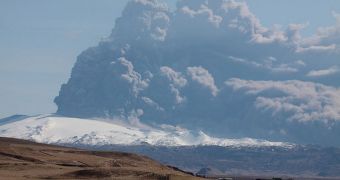Planetary scientists believe they may have discovered a way of keeping track of volcanic ash even at night, when the clouds are notoriously difficult to observe. They say that keeping an eye on the lightnings accompanying the clouds provides sufficient data to determine the height and path of clouds.
This conclusion was reached after experts analyzed the eruption of the volcano Eyjafjallajökull, which blew off this April in Iceland. The damage made by the event was widespread.
Residents of many European countries were forced to remain indoors for weeks due to atmospheric particles in ash clouds, that grew to cover most of the Old Continent.
Additionally, red sunsets were not at all uncommon throughout Europe, and the danger posed by the particles to aviation forced numerous companies to delay or cancel flights for months.
Climate experts and meteorologists usually keep track of these plumes through radar measurements, and also by using satellite data to establish their position and structure.
But these observation methods tend to fail at night, or when weather suddenly changes. Accurate readings become impossible to obtain, and this is where the new monitoring method comes in.
Each time ash clouds develop, they tend to produce large amounts of lightning in their upper reaches, and the team behind the new investigation says that keeping an eye out for these lights may help experts determine their location at night.
In the case of Eyjafjallajökull, it was determined that the height at which the lightnings developed was perfectly in tune with the height of the ash plumes themselves. These conclusions add additional credence to past studies that showed the same thing is true.
“There's the idea that volcanic eruptions are dirty thunderstorms,” explains Massachusetts Institute of Technology (MIT) atmospheric scientist Earle Williams, who was not a part of the new investigation.
“From a practical standpoint, the aviation industry is extremely concerned about volcanic eruptions. Airplanes don't even want to go in an ordinary thunderstorm, but this is worse,” he adds.
Ash particles in these clouds can easily clog up jet engines, leading to stalls and potential crashes. Airplanes are not allowed to fly through volcanic ash clouds, and need to go around them at all times.
In order to do that, it would help to know where the clouds are at all times, investigators say, and using lightnings is one way of finding that out. The reason why the Icelandic ice plumes created lightning was because the particles making it up were highly electrically-charged.
Details of the new investigation were published in the December 10 issue of the respected journal Environmental Research Letters, Our Amazing Planet reports.

 14 DAY TRIAL //
14 DAY TRIAL //